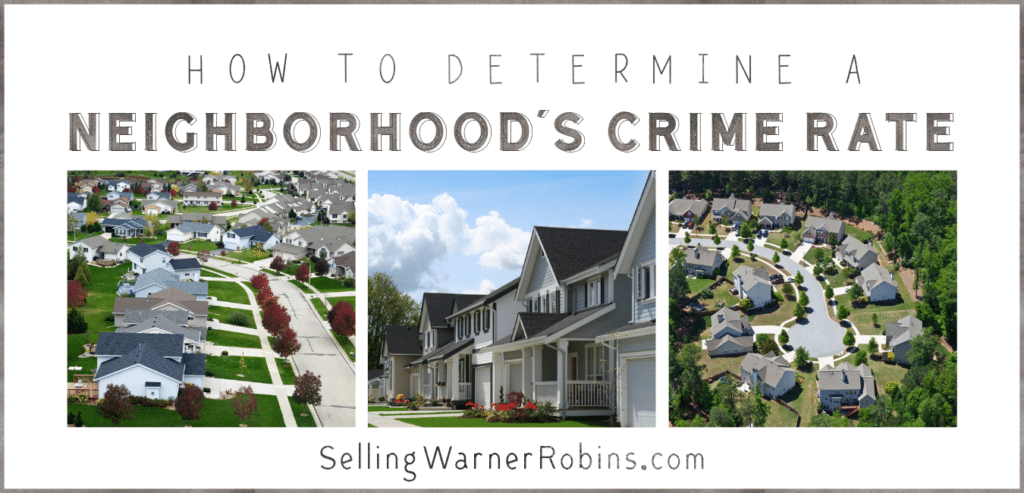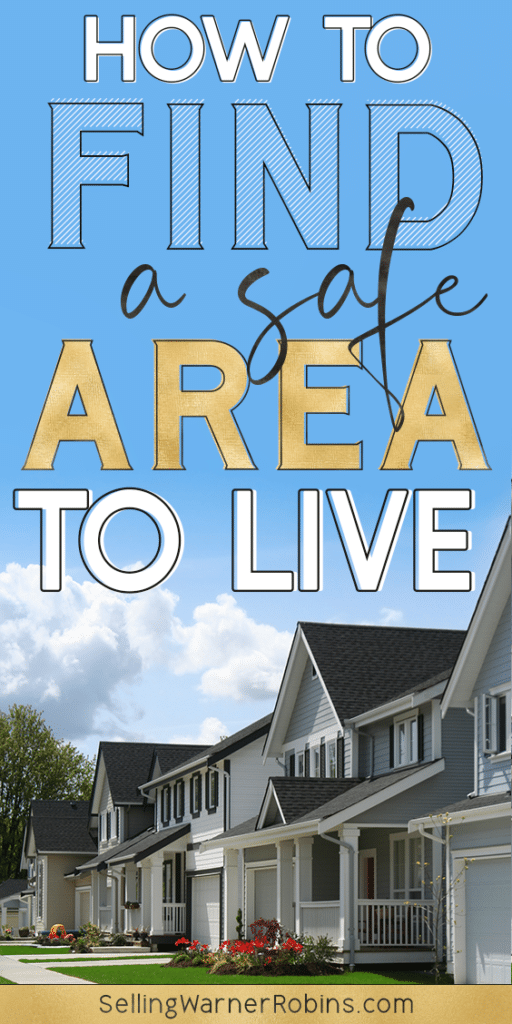Home Buyer FAQ: Does This Community Have Much Crime?

Living in a military city, it is very common to show houses to new home buyers who have never been to Warner Robins Georgia before. It is understandable they may be bit apprehensive, as are typically most new buyers around the country. All the more reason for consumers to follow the practical advice in this article when they start wondering (and asking) “Does this community have much crime?”.
Note: Realtors can not steer potential buyers or discriminate against or for a particular area. All research to determine if an area has a lot of crime (as determined by the buyer), is solely the responsibility of the buyer. The practical community crime tips in this article provide consumers a good basis to start their own neighborhood crime investigation.
Tips to Determine if a Community Has Much Crime
Shoppers in the housing market typically make a pro and con list prior to purchasing a home. Pros listed may include a well-maintained home with a newly installed roof, modernized living rooms, bathrooms, and kitchens, and additional room for expansion or other home construction projects. Cons listed may include a worn down exterior, unwanted and strong interior odors, and bad overall curb appeal.
However, future prospective homeowners are not solely looking at the pros and cons of the inside and outside of the house. They are also looking outward from their immediate surroundings – meaning the neighborhood that their home is centered in.
Everyone’s list may differ by a few items, but the gist of each will likely stay the same. For instance, a young couple may prioritize starting a family in the near future, whereas an older couple may want to downgrade the house a little bit to worry less about overall maintenance. Just like a single male may want a fixer upper with some cons to make profit out of the purchase, whereas a single female may want everything already put into place. And/or any combination of these scenarios too!

Questions like those below typically arise once the aforementioned “does this community have much crime” inquiry gets brought into the conversation:
- Is the area safe to live in?
- Is there a high crime rate?
- Are local law enforcement and police forces easily accessible?
- Do the locals stick together and report odd behavior or crime?
- Will I be able to walk the streets alone at night feeling safe?
- Do neighbors communicate when certain suspicious events occur?
- Are the streets well-lit?
- Is there a neighborhood watch?
- Are once popular storefronts now abandoned and ruined?
- Is there a constant police presence?
- Is crime and safety information readily available?
Of course, the questions, statements, and conversations do not stop there; those were just a few common examples.
Think about it like this: Future prospective homeowners are aiming to purchase a home that has a well-lit, safe, secure neighborhood. No one wants to voluntarily put themselves in a situation where they are not able to enjoy time well spent outside – whether it be playing with the kids, going for a walk, letting their dog outside, or freshening up the greenery and shrubs in the yard.
If the neighborhood is unsafe, that mean less time spent outside, breathing in the fresh air, playing, or just relaxing. That also means more time going directly from the car to the home and vice versa. It could also mean doors and windows shut and locked at all times. A fearful home resident is not the aim here. Instead, the aim is to find a home that is inviting, welcoming, comfortable, and so on.
Good thing it is fairly easy to gather your facts and come to a conclusion whether or not a neighborhood is safe or dangerous. Just adopt these tips and suggestions, and you should be good to go!
Tip #1: Have a quick conversation with the locals.
Take a drive around the neighborhood and check out the scenery. Are local shops doing good? Does it seem like they are struggling? Or does everything seem quite prosperous? Are most buildings abandoned or filled with newcomers?
Think about the local restaurants, coffee shops, and clothing stores. If customers are regularly purchasing from these local shops, chances are the crime rate is not high.
If you want to get the downlow on the neighborhood, we suggest heading on into a place of your choosing to check it out. Visit a restaurant or coffee shop and have a quick talk with the owners to get some insight on how the town works. You may need to visit a few establishments but local vendors are often a source of information about community crime.
Tip #2: Ask around to see if there is a neighborhood watch program.
Yes, a neighborhood watch is outdated as a crime prevention program by many, but some communities still rely on them as a deterrent. It has worked for decades and it is bound to work today, too. Nothing simpler than I watch your home and you watch mine for anything unusual or out of the ordinary.
Plus, if a particular neighborhood has one, the community is likely tight knit with the local law enforcement. Meaning, most all suspicious or criminal activity and behavior is immediately reported to the authorities and the residents so that everyone knows what is going on.
Tip #3: Attend some local events and see for yourself.
Neighborhoods that host community events and celebrations usually do not have as much crime, as opposed to cities and areas that do not hold get-togethers. Towns that do have high crime rates will want to stay away from gathering the townsfolk, as that could potentially harm them.
Think about it like this: Big and small events are common in a safe neighborhood. Farmers markets on the weekends, big business openings in the evenings, and so on.
Attend one of the local events yourself to see how safe the area is – talk to different people and get their point of view. Plus, introducing yourself will make you feel more confident and comfortable.
Tip #4: Keep an eye out for well-lit streets.

Take a drive in the prospective neighborhood at night to see exactly where the street lights and signs are positioned. Do they work properly? Are the signs in blatant view? Are they on from a certain set time onward, so that you are not walking from your car to your front door in the pitch black?
The goal is for you to feel safe in the community that you are going to live in, and that includes being able to go on a walk by yourself without worrying someone is following you in the darkness. For instance, if lighting is minimal, you will not be able to see others walking around you at night, and that is unsettling.
Suspicious behavior will likely happen where no one can see versus in plain sight. However, being mindful of your situation and surroundings at all times is recommended.
Tip #5: Avoid areas with abandoned storefronts and buildings.
Stores and restaurants closing almost have a direct correlation to high crime rates, especially if closings are happening quite often. Plus, it’s not the best idea to move right in on a city when said city has out-of-business businesses.
Think about it this way: Abandoned storefronts mean no one is occupying that rental space, which ultimately leads to a potential increase in property crime. Inadvertently, that increases chances of robbery, spray painting, loitering, damage, and so on.
Not to mention too many abandoned buildings in one area can pose a serious security problem. Best to avoid such scenarios if possible.
Tip #6: Check in on the overall high crime rate.
Believe it or not, entire cities do differ from smaller neighborhoods and areas. For instance, one area can have a high crime rate without the city being heavily associated with crime and vice versa.
All it takes is a quick internet search to check in on your specific area. Details are readily available on the internet and are never kept hidden when it comes to crime and crime-related offenses. A simple search will pinpoint some areas that are worse than others, too.
Tip #7: Make sure the landscaping is well-maintained.
Landscaping sets the tone for a neighborhood or a group of houses. That is why well-maintained lawns with trees and sprinklers do not have high crime around. On the other hand, lawns that are overgrown and house litter often do have high crime potential in the immediate surrounding areas.
Think about it: Residents that put in time and effort into properly maintaining their lawn, home, and curb appeal will want to show it off to the general public. They would not want it to be trashed. If high crime is prevalent in such areas, residents are not going to want to display something that may be destroyed or stolen..
Tip #8: Pay attention to police presence and respondents in the neighborhood.
Police officers have a very important job: To respond to any and all local crimes. They want to make you feel safe and sound in your neighborhood because, well, that is your home.
However, areas with high police activity should have a warning label on them, as these are bad zones. Think about this: How often do you see the lights flashing and hear the sirens sounding? Do they often come your way towards the home you are interested in purchasing?
We know, it is extremely difficult to answer those questions because currently, you are not living in said neighborhood; you are simply looking to buy the property. Easy fix!
As previously stated, do a drive by in the neighborhood, or a couple of them. Choose different times of the day and night just to get a better feel for the cop cruisers, if any.
Remember, if there is a police car driving through a neighborhood, that is not always a bad sign; he or she could be patrolling the area as part of their beat. Keeping a close watch and establishing a relationship with the citizens of the town is positive reinforcement against crime, after all.
Tip #9: Check to see if there is a variety of grocery stores and restaurants in the surrounding areas.

It is a clear coat danger sign if there is a lack of grocery stores and restaurants in a given area. Think about it: When a particular city has high poverty rates, high crime rates often follow; it is a tale as old as time, unfortunately.
Moreover, poverty stricken areas usually lack an ample supply of fresh fruits and veggies and healthy foods too. Maybe it is distribution or cost but they often go hand-in-hand.
To replace all of the nutritious food items, some poverty and crime-related neighborhoods will incorporate fast food chains and a ton of quick stop marts. So, pay attention and see what the area is known for or has an over-abundance of.
Tip #10: A lot of rental properties may lead to a high crime rate.
A population that has increased rental populations is one to take a closer look at. The rise in rentals could be a normal flux, an anomaly, due to specific market conditions, and it could also be because owners have rented out their properties to leave the community. When in doubt, ask locals!
Think about this: If tenants are constantly leaving properties, there is a strong likelihood that increased crime is in surrounding areas. Chances are the tenants did not want to stay there any longer because of the rate of crime, or they could not stay there any longer because they were potentially starting or involved with the crime.
Tip #11: Introduce yourself to your potential neighbors.
Actually knowing and verbal communicating with potential neighbors is a great way to stay in the loop and keep local crime low. After all, positive communication is key to harmonious relationships.
Think about it: A relationship from one homeowner to the next homeowner will matter and make a difference; it is extremely important and sets up the perfect situation for everyone’s safety. One neighbor can watch out for the next and alert the others if anything suspicious is currently happening or is about to happen.
Tip #12: Clue yourself and others in on crime prevention and the appropriate safety information.
Crime prevention pamphlets and safety information is not hard to come by, but if you do not know the basics, just ask around! A local first responding team will be more than happy to provide answers to any questions you may have.
Then, you can forward the information to the appropriate parties in your potential new neighborhood.
If you want to overly prepare yourself, get on the internet and do some additional research just to be safe and sound.
Community Crime Resources
- Review the Georgia Sex Offender Registry
- Visit Spotcrime.
- Check out CrimeReports.
- Research using Neighborhood Scout.
- Scan through the FBI Uniform Crime Reports.
Note: Although criminals/crime are not one of the protected classes under the Federal Fair Housing Act, it is important for buyers to choose the subdivision/community they want to live in based entirely on their own standards of what a “safe neighborhood” entails.
Keeping our families safe is at the top of every parents list and knowing where to go to check on past crimes and crime rates can help make the home buying process an easier decision. That is just one of the many reasons to employ the services of a well qualified real estate agent for your local needs.
Final Community Crime Tips
Once the basics are covered and all the information is gathered about the neighborhood you are looking into, the answer to the question “does this community have much crime” should be an easy one to find.
Note some of our tips, have a sit-down conversation with housemates or family members (if there will be any living with you), and answer all the necessary questions that come up in conversation.
Determining if a community has crime is not difficult; all it takes is some time and dedication to get the answers you are looking for. Safety is definitely on the pros list, so confirming that your potential one-day home is secure can never make you overly cautious; it just makes you super smart and puts you ahead of the game!
if you found this article insightful, please share it so other consumers who are asking about community crime know what to be on the lookout for.
How Much Crime Does This Community Have?
About Anita Clark Realtor
Anita Clark has written 646 posts on this blog.
by Anita Clark Anita is a residential Real Estate Agent in Warner Robins Georgia, with Coldwell Banker Access Realty (478) 953-8595, aiding buyers and sellers with all their real estate questions on her Warner Robins blog.




